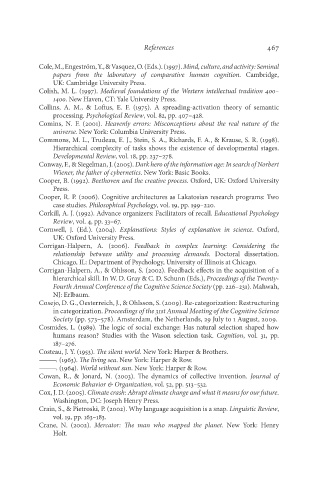Page 484 - Deep Learning
P. 484
References 467
Cole, M., Engeström, Y., & Vasquez, O. (Eds.). (1997). Mind, culture, and activity: Seminal
papers from the laboratory of comparative human cognition. Cambridge,
UK: Cambridge University Press.
Colish, M. L. (1997). Medieval foundations of the Western intellectual tradition 400–
1400. New Haven, CT: Yale University Press.
Collins, A. M., & Loftus, E. F. (1975). A spreading-activation theory of semantic
processing. Psychological Review, vol. 82, pp. 407–428.
Comins, N. F. (2001). Heavenly errors: Misconceptions about the real nature of the
universe. New York: Columbia University Press.
Commons, M. L., Trudeau, E. J., Stein, S. A., Richards, F. A., & Krause, S. R. (1998).
Hierarchical complexity of tasks shows the existence of developmental stages.
Developmental Review, vol. 18, pp. 237–278.
Conway, F., & Siegelman, J. (2005). Dark hero of the information age: In search of Norbert
Wiener, the father of cybernetics. New York: Basic Books.
Cooper, B. (1992). Beethoven and the creative process. Oxford, UK: Oxford University
Press.
Cooper, R. P. (2006). Cognitive architectures as Lakatosian research programs: Two
case studies. Philosophical Psychology, vol. 19, pp. 199–220.
Corkill, A. J. (1992). Advance organizers: Facilitators of recall. Educational Psychology
Review, vol. 4, pp. 33–67.
Cornwell, J. (Ed.). (2004). Explanations: Styles of explanation in science. Oxford,
UK: Oxford University Press.
Corrigan-Halpern, A. (2006). Feedback in complex learning: Considering the
relationship between utility and processing demands. Doctoral dissertation.
Chicago, IL: Department of Psychology, University of Illinois at Chicago.
Corrigan-Halpern, A., & Ohlsson, S. (2002). Feedback effects in the acquisition of a
hierarchical skill. In W. D. Gray & C. D. Schunn (Eds.), Proceedings of the Twenty-
Fourth Annual Conference of the Cognitive Science Society (pp. 226–231). Mahwah,
NJ: Erlbaum.
Cosejo, D. G., Oesterreich, J., & Ohlsson, S. (2009). Re-categorization: Restructuring
in categorization. Proceedings of the 31st Annual Meeting of the Cognitive Science
Society (pp. 573–578). Amsterdam, the Netherlands, 29 July to 1 August, 2009.
Cosmides, L. (1989). The logic of social exchange: Has natural selection shaped how
humans reason? Studies with the Wason selection task. Cognition, vol. 31, pp.
187–276.
Costeau, J. Y. (1953). The silent world. New York: Harper & Brothers.
———. (1963). The living sea. New York: Harper & Row.
———. (1964). World without sun. New York: Harper & Row.
Cowan, R., & Jonard, N. (2003). The dynamics of collective invention. Journal of
Economic Behavior & Organization, vol. 52, pp. 513–532.
Cox, J. D. (2005). Climate crash: Abrupt climate change and what it means for our future.
Washington, DC: Joseph Henry Press.
Crain, S., & Pietroski, P. (2002). Why language acquisition is a snap. Linguistic Review,
vol. 19, pp. 163–183.
Crane, N. (2002). Mercator: The man who mapped the planet. New York: Henry
Holt.

